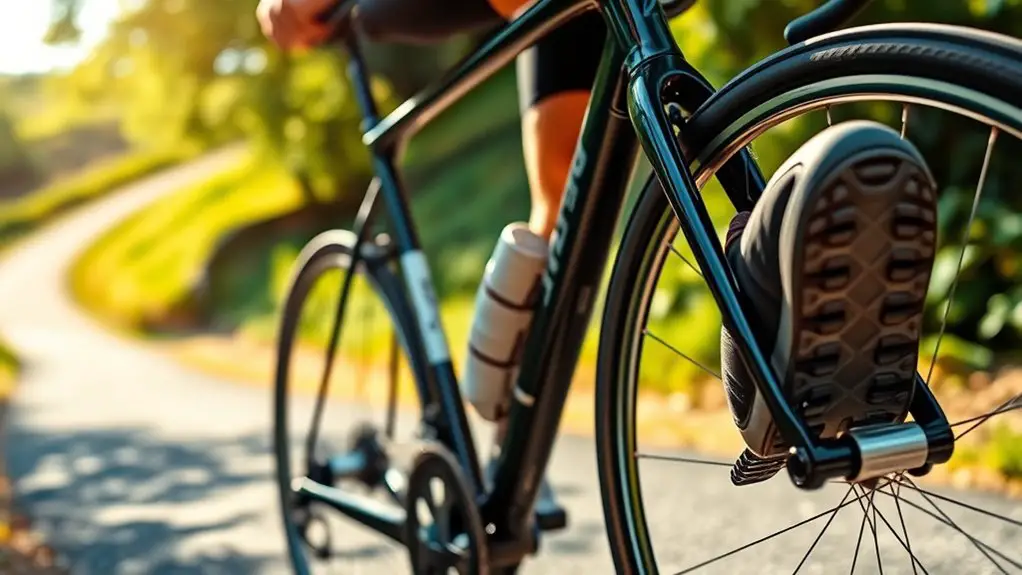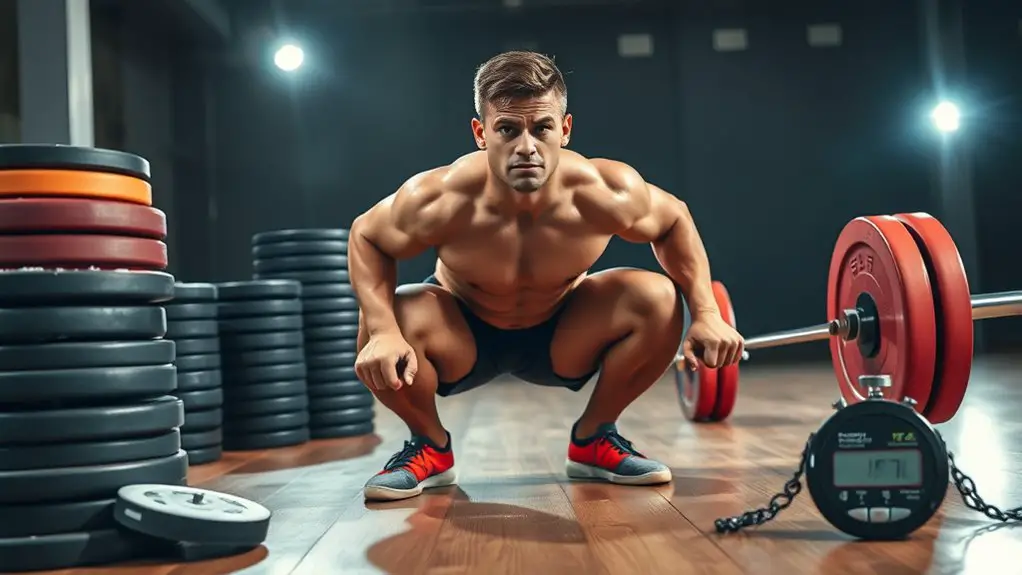To develop stronger glutes for better pedal power, focus on essential exercises like glute bridges, squats, and lunges at least 2-3 times a week. Incorporate single-leg movements like deadlifts for balanced strength. Prioritize proper nutrition with lean proteins and hydration to fuel muscle growth and recovery. Don't forget to track your progress to fine-tune your routine. With these strategies, you'll boost your cycling efficiency and performance, and there's more to explore for even better results.
Understanding the Role of Glutes in Cycling
When it comes to cycling, your glutes play an essential role in powering your ride. These muscles aren't just for show; they're critical for glute activation, which directly impacts your cycling efficiency. Strong glutes help you push down with force while pedaling, allowing for smoother, more powerful strokes. When your glutes engage properly, you'll notice a significant boost in your overall performance, helping you conquer those challenging hills and long distances with ease. Additionally, incorporating glute activation exercises into your routine can significantly enhance your strength and stability on the bike.
If you're craving that sense of freedom on the open road, it's important to prioritize your glute strength. A well-activated posterior chain means less strain on your back and legs, enabling you to ride longer and faster. So, take a moment to focus on your glutes before you hit the trails. Embrace the wind in your hair and the thrill of the ride, knowing that strong glutes can elevate your cycling experience to new heights.
Essential Glute Exercises for Cyclists
To maximize your cycling performance, incorporating essential glute exercises into your routine is vital. Strong glutes not only enhance your power but also improve endurance and stability on the bike. Start with glute bridges to activate those muscles; simply lie on your back, knees bent, and lift your hips towards the sky. Next, try single-leg deadlifts to challenge your balance while further engaging your glutes. These moves promote glute activation, which is important for efficient pedaling.
Don't forget about squats—whether bodyweight or weighted, they'll build overall strength in your lower body. Lunges, too, can greatly boost your cycling performance by targeting various muscle groups, including the glutes. Finally, consider resistance band exercises like clamshells to isolate and strengthen your glute medius. Incorporating squats and lunges into your routine will enhance your overall strength, contributing to better cycling performance. By regularly integrating these exercises, you'll release your potential and enjoy the freedom of riding with greater power and stability.
Incorporating Strength Training Into Your Routine
To build stronger glutes, you need to incorporate effective strength training exercises into your routine. This means understanding essential exercises, determining the right frequency and volume, and mastering proper form and technique. Let's explore how to make these elements work together for ideal results. Additionally, focusing on compound movements is crucial for maximizing your glute strength development.
Essential Exercises for Glutes
Incorporating essential exercises into your routine can considerably enhance your glute strength and shape. To achieve that freedom of movement you crave, focus on glute activation through targeted workouts. Squats, lunges, and hip thrusts are fantastic for building power and addressing muscle imbalances. Start with bodyweight versions to master form, then add resistance as you progress. Don't forget to include single-leg exercises like step-ups or Bulgarian split squats; they're great for ensuring both sides of your body work evenly. Remember, consistency is key. By regularly including these exercises, you'll not only develop stronger glutes but also improve your overall performance and stability. Embrace the journey to freedom through strength—your glutes will thank you!
Frequency and Volume Guidelines
Finding the right frequency and volume for your glute training is essential for maximizing results. Aim to activate those glutes at least two to three times a week, allowing your body to recover between sessions. Each workout should include 3 to 4 sets of 8 to 12 reps for peak glute activation, focusing on quality over quantity. Don't forget to incorporate recovery strategies like stretching and foam rolling to keep your muscles healthy and ready for action. Listen to your body; if you're feeling fatigued, adjust your frequency to avoid burnout. By finding that sweet spot, you'll not only develop stronger glutes but also enhance your overall cycling performance and enjoy the freedom of movement that comes with it.
Proper Form and Technique
Mastering proper form and technique is essential when it comes to effectively incorporating strength training into your routine. Focusing on the hip hinge is key; it sets the foundation for powerful glute activation. When you hinge at the hips, maintain a straight back and engage your core, allowing your glutes to do the heavy lifting.
Next, pay attention to squat depth. Ideally, you should aim for a depth where your thighs are parallel to the ground, ensuring you're activating those glutes fully. Don't rush through your reps; control each movement, feeling the muscles work. Remember, good form not only maximizes gains but also minimizes injury risk. Embrace this technique, and you'll find freedom in your strength training journey.
Tips for Proper Form and Technique
Achieving the best results from your glute workouts hinges on proper form and technique. When you focus on glute activation, you'll not only build strength but also enhance your pedal efficiency. Here are some tips to keep in mind:
- Engage your core: A strong core stabilizes your body, allowing your glutes to do the heavy lifting. This stability is crucial for enhancing movement efficiency during your workouts.
- Mind your alignment: Keep your knees in line with your toes to prevent injury and maximize glute engagement.
- Control your movements: Slow, deliberate motions during exercises help guarantee that you're effectively activating your glutes.
Balancing Strength and Endurance Training
While many focus solely on strength or endurance, balancing both is essential for developing stronger glutes. By integrating strength training with endurance workouts, you can achieve ideal workout balance, enhancing your glute performance for all activities, especially cycling.
| Training Type | Focus |
|---|---|
| Strength Training | Build muscle power |
| Endurance Training | Improve stamina |
| Mixed Workouts | Enhance overall fitness |
| Recovery Sessions | Promote muscle repair |
| Flexibility Work | Support joint health |
Incorporating both strength endurance and endurance exercises will guarantee your glutes are not just strong but also resilient. Aim for a mix of heavy lifts, like squats and deadlifts, alongside high-rep endurance workouts, like cycling or running. This combination fosters freedom in movement and stability, allowing you to ride longer and stronger, freeing your full potential on the bike. Additionally, enhanced recovery times lead to quicker bounce-back between sessions, further supporting your glute training efforts.
Nutrition for Muscle Growth and Recovery
To fuel muscle growth and aid recovery, it's important to pay attention to your nutrition. Your body craves the right balance of nutrients, especially when you're pushing it to the limit. Here are some key points to reflect on:
- Prioritize protein sources: Incorporate lean meats, legumes, and dairy for muscle repair.
- Master meal timing: Eat strategically around your workouts for ideal impact.
- Stay hydrated and include anti-inflammatory foods: Proper hydration and foods like berries and leafy greens can enhance recovery.
Don't forget about recovery foods after your workouts; they're critical for post workout recovery. Supplement options can also support your goals, but focus on whole foods first. Micronutrient importance can't be overstated, as vitamins and minerals play significant roles in muscle function. With effective pre workout nutrition and smart nutrient timing, you'll set the stage for stronger glutes and better pedal power.
Additionally, ensuring adequate protein intake is vital as it reduces soreness and accelerates recovery time, enhancing your performance in future workouts.
Tracking Progress and Adjusting Your Training Plan
Tracking your progress is key to ensuring that your training plan is effective in building stronger glutes. By keeping a record of your workouts, you'll see what's working and what needs tweaking. Whether you're logging weights, reps, or how you feel during each session, progress tracking helps you stay motivated and connected to your goals. Additionally, incorporating hydration strategies post-workout can enhance your recovery and improve overall performance. As you progress, don't hesitate to make training adjustments. If you notice your gains slowing down, it might be time to increase weights, change exercises, or alter your rep ranges. This dynamic approach not only prevents plateaus but also keeps your routine exciting. Remember, freedom lies in knowing you can adapt your training to fit your evolving needs.
Frequently Asked Questions
How Long Does It Take to See Glute Strength Improvements?
When you're working on glute strength, it usually takes about 4 to 8 weeks to notice improvements. This timeframe can vary based on your glute activation techniques and overall strength progression. If you're consistent with your workouts and focus on proper form, you'll likely feel a difference sooner. Embrace the journey, and remember, every small step you take leads to greater freedom and power in your movements. Keep pushing, and the results will come!
Can Cycling Alone Strengthen My Glutes Effectively?
Can you really rely on cycling alone to strengthen your glutes? It's tempting, but while cycling offers great benefits, it might not activate your glutes as effectively as you'd want. Sure, you'll feel the burn, but to truly sculpt those muscles, mixing in specific glute exercises can release your potential. Embrace that freedom to explore different workouts, and you'll find the perfect blend for glute activation and strength improvement.
Are There Any Glute Stretches for Cyclists?
Yes, there are effective glute stretches for cyclists! Incorporating flexibility routines can enhance your glute activation and overall performance. Try stretches like the pigeon pose or figure-four stretch to open up your hips and engage those muscles. These movements not only improve flexibility but also promote better blood flow, helping you feel freer on the bike. Remember, a well-rounded approach to stretching can really elevate your cycling experience and boost your glute strength!
Should I Focus on Glute Strength or Overall Leg Strength?
When it comes to strength training, you can't have your cake and eat it too! Focusing on glute strength is essential, but don't overlook overall leg power. Glute activation plays a vital role in enhancing your performance and stability. By combining both, you'll not only build a solid foundation but also enjoy the freedom to tackle any challenge that comes your way. So, balance your workouts for the best results!
What Common Mistakes Should I Avoid in Glute Training?
When training your glutes, there are common mistakes you should avoid. First, neglecting proper glute activation can hinder your progress—always engage your glutes before starting exercises. Also, poor exercise form can lead to injuries and ineffective workouts; maintain a strong core and aligned posture. Don't rush through reps; focus on quality over quantity. By correcting these habits, you'll release your glutes' full potential and enjoy the freedom of powerful movement.




